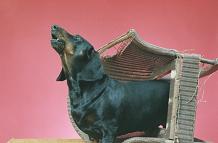Have you ever wondered what your dog does when you are not at home?
Does Poochie quietly wander the garden, sniffing at the daisies, rolling in the sun generally behaving in a content and happy manner?

Behaviours like this are very common. Many people call this behaviour fretting but it is really a condition called a Separation Anxiety.
It occurs because your dog is extremely attached to you and becomes over-dependant. It is a by-product of the fact that dogs are pack animals and prefer to live in a social grouping or a pack. Those of us who love our dogs dearly often cause an over dependency in our dogs. Our devotion to them when we are home make them regard us as their pack leader. When we go to work or even to bed at night, the dog is forced to lead a life of isolation and that’s when the stress and the anxiety start.
How do you know if your pet has a Separation Anxiety?
Look at your dog’s behaviour when you leave for work and come home. If your dog is quiet, unhappy, morose or has that “You’re going to leave me again you mean, uncaring owner” look then you should be suspicious of an early Separation Anxiety. When you return, if the dog goes over the top with the joy of seeing you – barking, whining, jumping up and overtly attention seeking then your suspicions are mostly confirmed. If your dog is also destructive, and digs holes or the neighbours complain about excessive barking or escaping, then that clinches your diagnosis.
Many dogs show physiological signs of stress in the owner’s absence too. Signs such as trembling, shaking, excessive salivation, drooling or hyperventilation are called autonomic signs and indicated that the flight/fight response has been activated.
Dogs which are confined will often soil their enclosure or your home if that is where you are leaving them and some dogs develop introverted behaviour such as self mutilation. This can include licking or chewing of the paws and the upper part of the foreleg. On the foreleg, a gradually enlarging lesion caused by the continual licking and chewing can occur. This is call an Acral Lick Dermatitis. They look ugly and can be difficult to control.
Lastly, there is escaping behaviour. Dogs with a Separation Anxiety often continually escape from their backyards despite immense efforts from their owners to stop them from so doing. One dog I have been treating was an awful escape artist. He use to jump through plate glass windows and had cut the end of his tongue off by doing this. He also bent a swimming pool fence to get out and pulled the door jams off a room he was confined in. Another dog straddled a powerful electric cattle fence, receiving continual shocks while she dug out under the barrier fence.
Behaviours like this are obviously a problem for the owner but think about the dog! These pooches are really stressed out and their welfare is at risk.
Contents of the next page
1. The Trial Separations Technique
2. Why Bored Relief is Important
